key CADILLAC DEVILLE 1998 7.G Owners Manual
[x] Cancel search | Manufacturer: CADILLAC, Model Year: 1998, Model line: DEVILLE, Model: CADILLAC DEVILLE 1998 7.GPages: 386, PDF Size: 22.36 MB
Page 18 of 386

Downloaded from www.Manualslib.com manuals search engine Power Lumbar Control (If Equipped) Memory Seat and Mirrors (If Equipped)
The
LUMBAR control is
located on the outboard side
of each front seat. It
provides additional support
to your lower back and it
works independently of the
other seat controls. Use the
power seat control first to
get the proper position.
Then proceed with the
lumbar adjustment.
To reshape the lower seatback, move the LUMBAR
switch forward to increase support and rearward to
decrease support. Move the LUMBAR switch side to
side to raise or lower the support mechanism to suit
your preference.
Keep in mind that as your seating position changes, as it
may during long trips,
so should the position of your
lumbar support. Adjust the seat as needed.
If you have the optional personalization package, the
power lumbar control can be programmed for memory
recall. For more information, see “Programmable, Memory and Personalization Features” in the Index. Automatic seat and mirror movement will occur if the
Remote Keyless Entry
(RE) transmitter is used to
enter the vehicle. The number on the back of the
transmitter corresponds to the
1 or 2 seat and
mirror position.
After the unlock button is pressed on the
RKE
transmitter (the ignition must be in LOCK) or when the
key is placed in the ignition, the seat and mirrors will
automatically adjust to the appropriate position.
1-3
Page 19 of 386
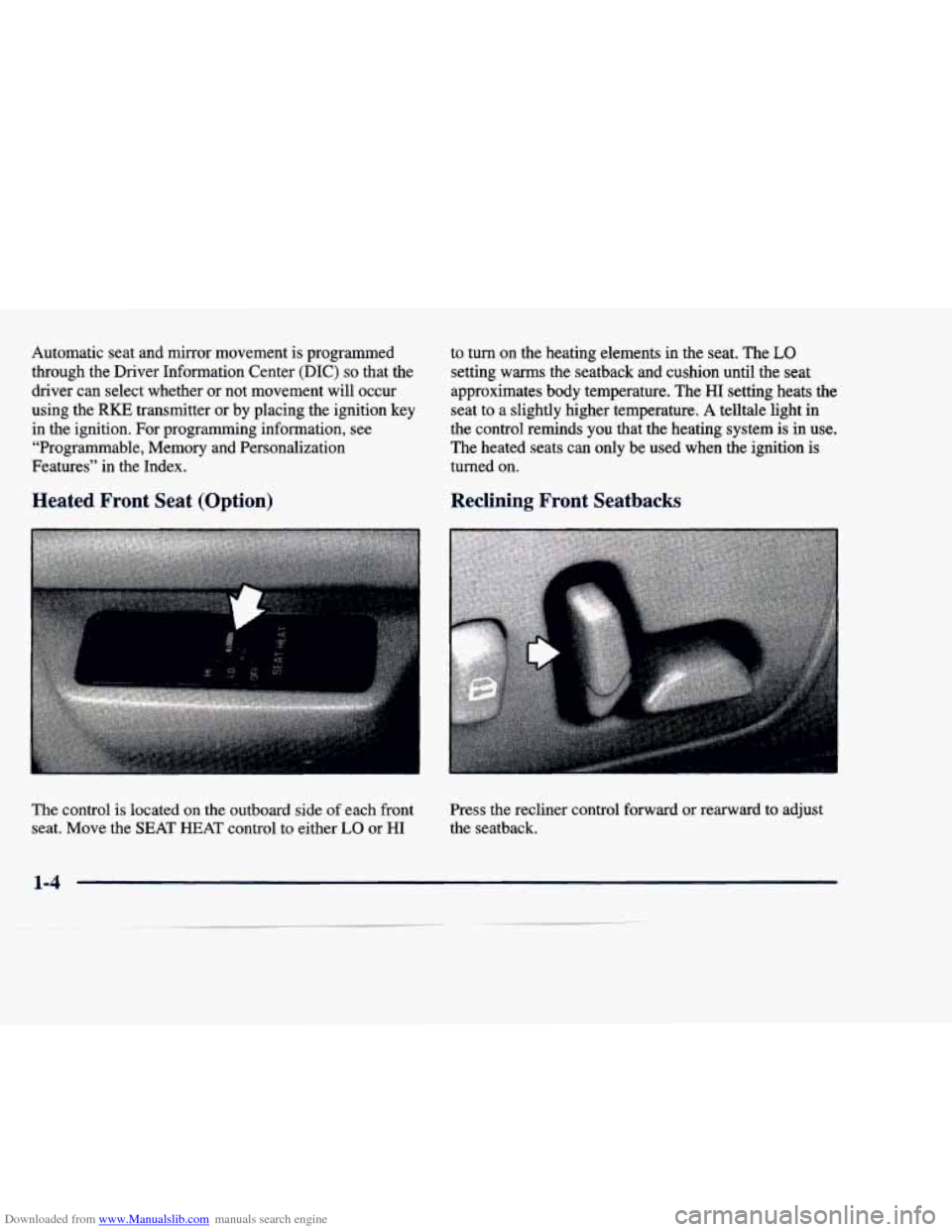
Downloaded from www.Manualslib.com manuals search engine Automatic seat and mirror movement is programmed
through the Driver Information Center (DIC)
so that the
driver can select whether or not movement will occur
using the
RKE transmitter or by placing the ignition key
in the ignition. For programming information, see
“Programmable, Memory and Personalization
Features” in the Index.
Heated Front Seat (Option)
The control is located on the outboard side of each front
seat. Move the
SEAT HEAT control to either LO or HI to turn on the heating elements in the seat.
The
LO
setting warms the seatback and cushion until the seat
approximates body temperature. The
HI setting heats the
seat to a slightly higher temperature.
A telltale light in
the control reminds you that the heating system is in use.
The heated seats can only be used when the ignition is
turned on.
Reclining Front Seatbacks
Press the recliner control forward or rearward to adjust
the seatback.
1-4
Page 36 of 386
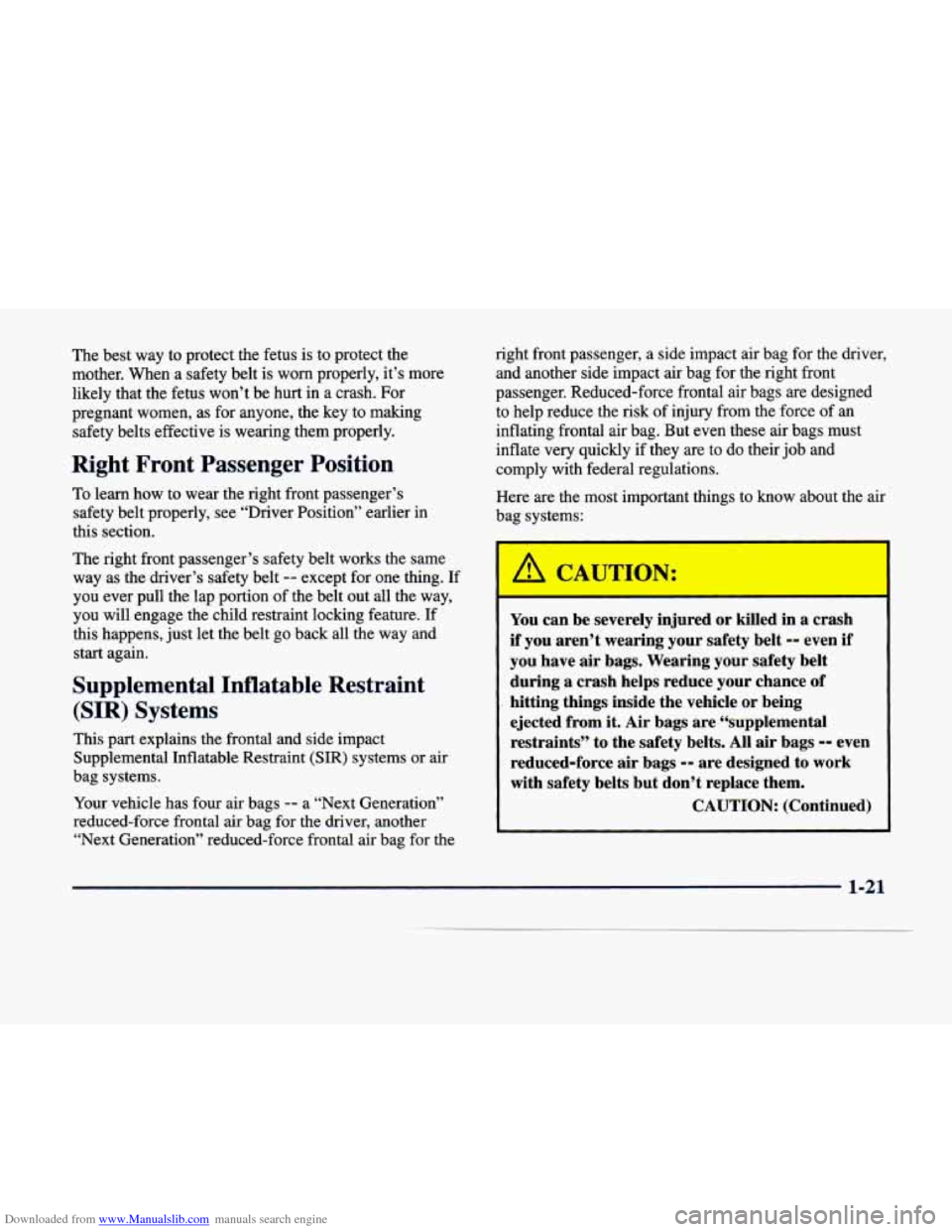
Downloaded from www.Manualslib.com manuals search engine The best way to protect the fetus is to protect the
mother. When a safety belt is worn properly, it’s more
likely that the fetus won’t be hurt in a crash. For
pregnant women, as for anyone, the key to making
safety belts effective is wearing them properly.
Right Front Passenger Position
To learn how to wear the right front passenger’s
safety belt properly, see “Driver Position” earlier in
this section.
The right front passenger’s safety belt works the same
way as the driver’s safety belt
-- except for one thing. If
you ever pull the lap portion of the belt out all the way,
you will engage the child restraint locking feature.
If
this happens, just let the belt go back all the way and
start again.
Supplemental Inflatable Restraint
(SIR) Systems
This part explains the frontal and side impact
Supplemental Inflatable Restraint (SIR) systems or air
bag systems.
Your vehicle has four air bags
-- a “Next Generation”
reduced-force frontal air bag for the driver, another
“Next Generation” reduced-force frontal air bag for the right
front passenger, a side impact air bag for the driver,
and another side impact air bag for the right front
passenger. Reduced-force frontal air bags are designed to help reduce the
risk of injury from the force of an
inflating frontal air bag. But even these air bags must
inflate very quickly if they are to do their job and
comply with federal regulations.
Here are the most important things
to know about the air
bag systems:
You can be severely injured or killed in a crash
if you aren’t wearing your safety belt
-- even if
you have air bags. Wearing your safety belt
during a crash helps reduce your chance of
,. hitting things inside the vehicle or being
ejected from it. Air bags are “supplemental
’ restraints” to the safety belts. All air bags -- even
reduced-force air bags
-- are designed to work
with safety belts but don’t replace them.
CAUTION: (Continued)
1-21
Page 44 of 386
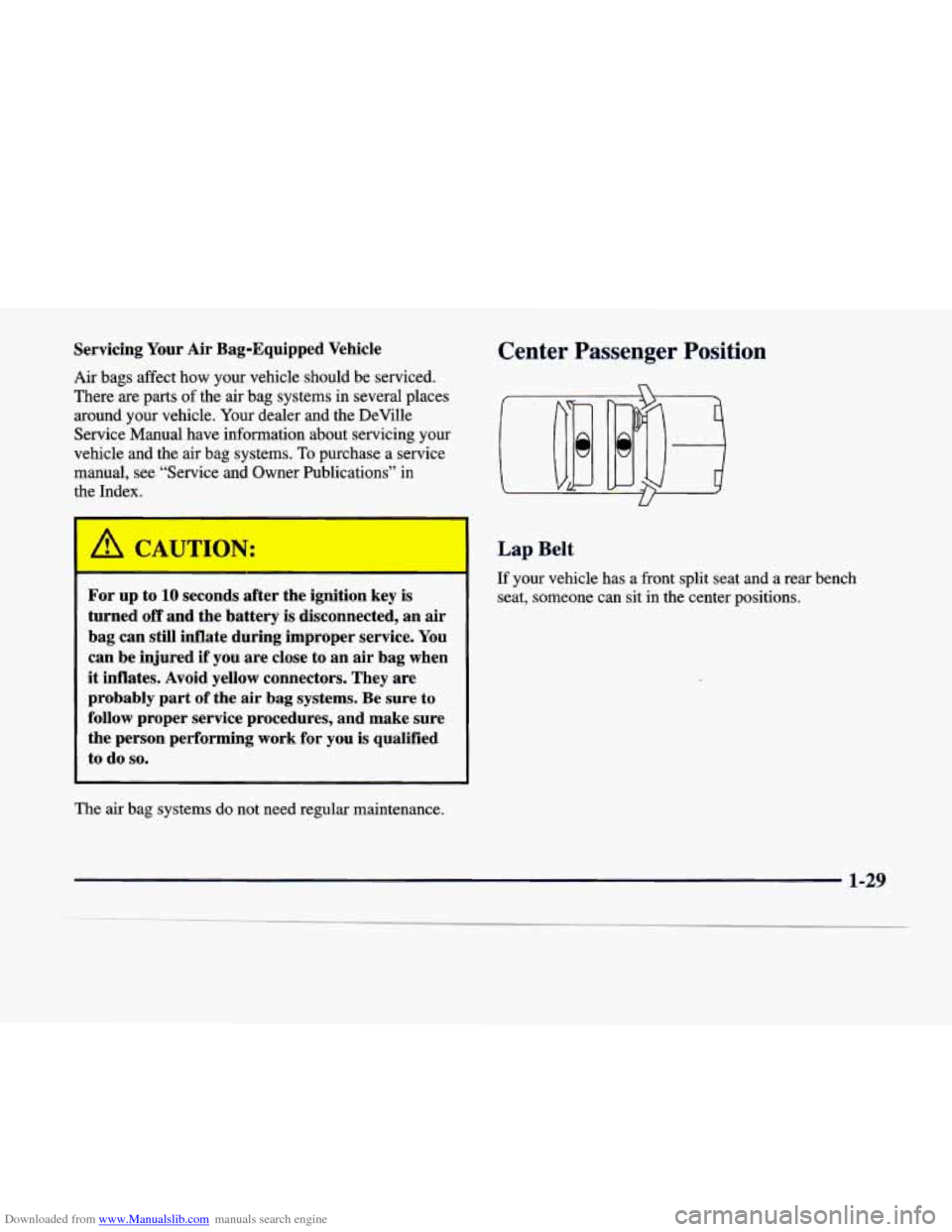
Downloaded from www.Manualslib.com manuals search engine Servicing Your Air Bag-Equipped Vehicle
Air bags affect how your vehicle should be serviced. There are
parts of the air bag systems in several places
around your vehicle. Your dealer and the DeVille
Service Manual have information about servicing your
vehicle and the air bag systems.
To purchase a service
manual, see “Service and Owner Publications” in
the Index.
/1 CAUTION:
I
For up to 10 seconds after the ignition key is
turned off and the battery is disconnected, an air
bag can still inflate during improper service. You
can be injured if you are close
to an air bag when
it inflates. Avoid yellow connectors. They are
probably part
of the air bag systems. Be sure to
follow proper service procedures, and make sure
the person performing work for you is qualified
to do
so.
The air bag systems do not need regular maintenance.
Center Passenger Position
Lap Belt
If your vehicle has a front split seat and a rear bench
seat, someone can sit in the center positions.
1-29
Page 72 of 386
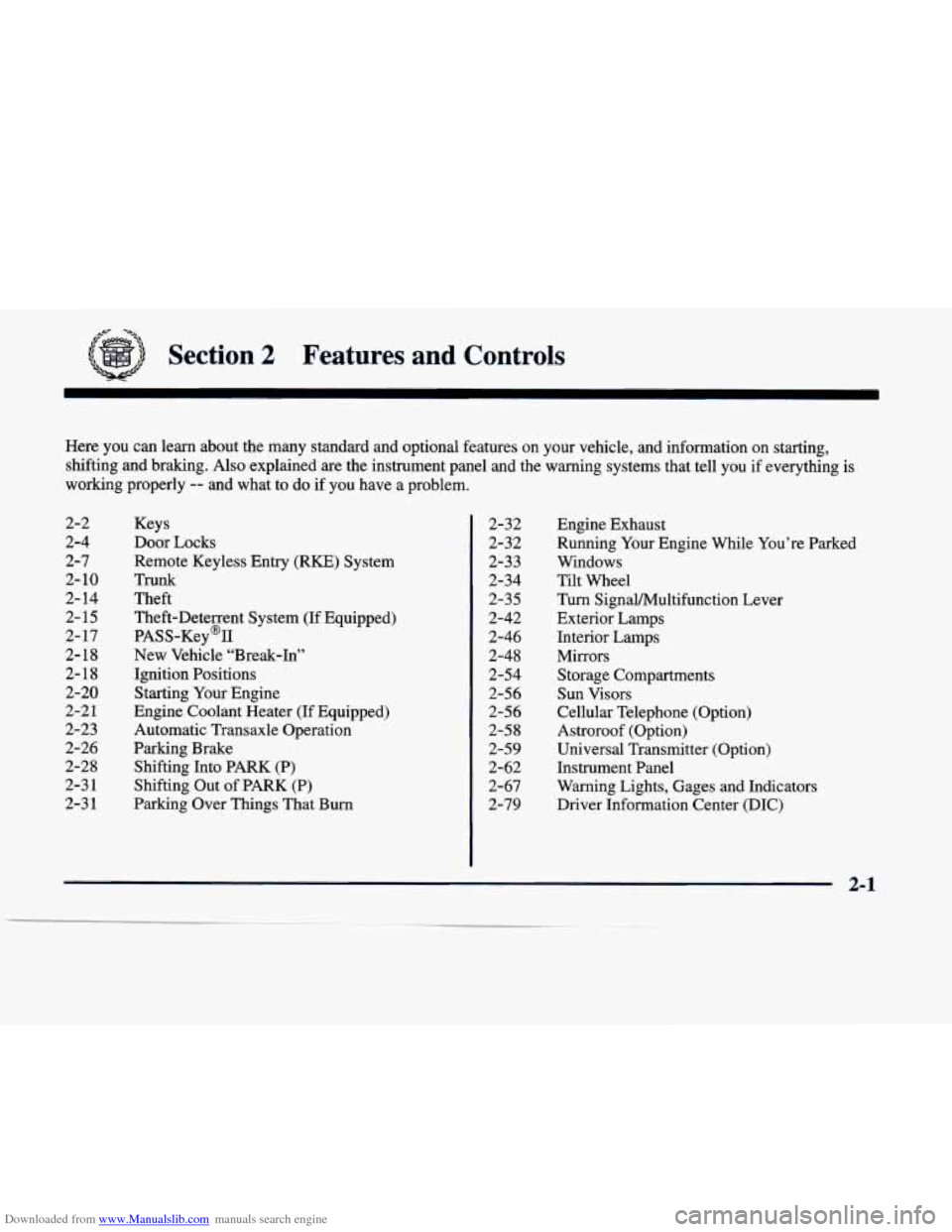
Downloaded from www.Manualslib.com manuals search engine Features and Controls
Here you can learn about the many standard and optional features on your ve\
hicle, and information on starting,
shifting
and braking. Also explained are the instrument panel and the warning systems that tell you if everything is
working properly
-- and what to do if you have a problem.
2-2
2-4
2-7
2- 10
2- 14 2-15
2-17
2- 18
2-18
2-20
2-2
1
2-23
2-26
2-28
2-3
1
2-3 1 Keys
Door Locks
Remote Keyless Entry (RKE) System
Trunk
Theft Theft-Deterrent System (If Equipped)
PASS-Key’II
New Vehicle “Break-In’’
Ignition Positions
Starting Your Engine
Engine Coolant Heater (If Equipped)
Automatic Transaxle Operation
Parking Brake Shifting Into PARK
(P)
Shifting Out of PARK (P)
Parking Over Things That Burn 2-32
2-32
2-33
2-34
2-35 2-42
2-46
2-48
2-54
2-56
2-56
2-5 8
2-59
2-62
2-67
2-79 Engine Exhaust
Running Your Engine While You’re Parked
Windows
Tilt Wheel
Turn SignaUMultifunction Lever
Exterior Lamps
Interior Lamps
Mirrors
Storage Compartments
Sun Visors
Cellular Telephone (Option)
Astroroof (Option)
Universal Transmitter (Option)
Instrument Panel
Warning Lights, Gages and Indicators Driver Information Center (DIC)
Page 73 of 386
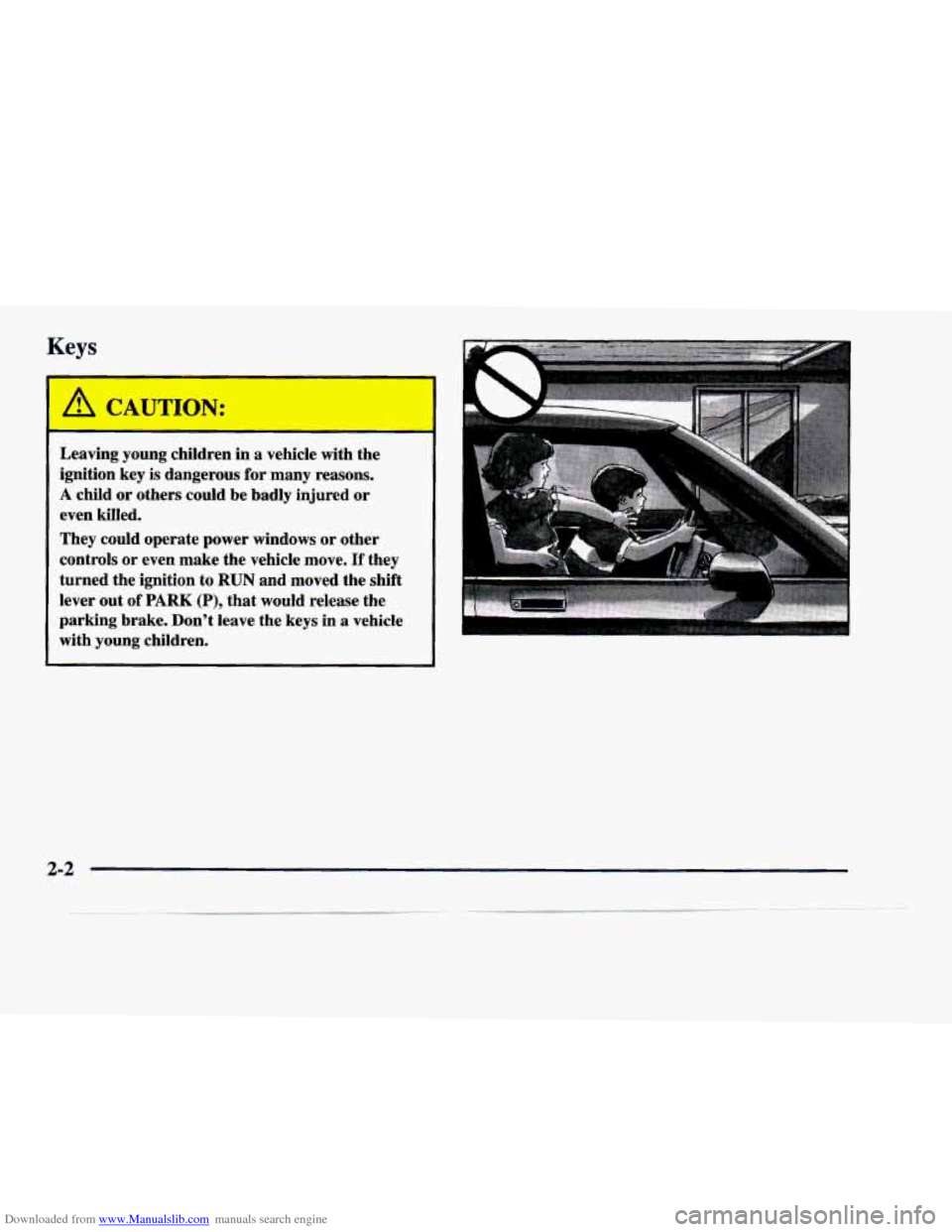
Downloaded from www.Manualslib.com manuals search engine Keys
A CAUTION:
Leaving young children in a vehicle with the
ignition key is dangerous for many reasons.
A child or others could be badly injured or
even killed.
They could operate power windows or other
controls
or even make the vehicle move. If they
turned the ignition to
RUN and moved the shift
lever out
of PARK (P), that would release the
parking brake. Don’t leave the keys
in a vehicle
with young children.
2-2
Page 74 of 386
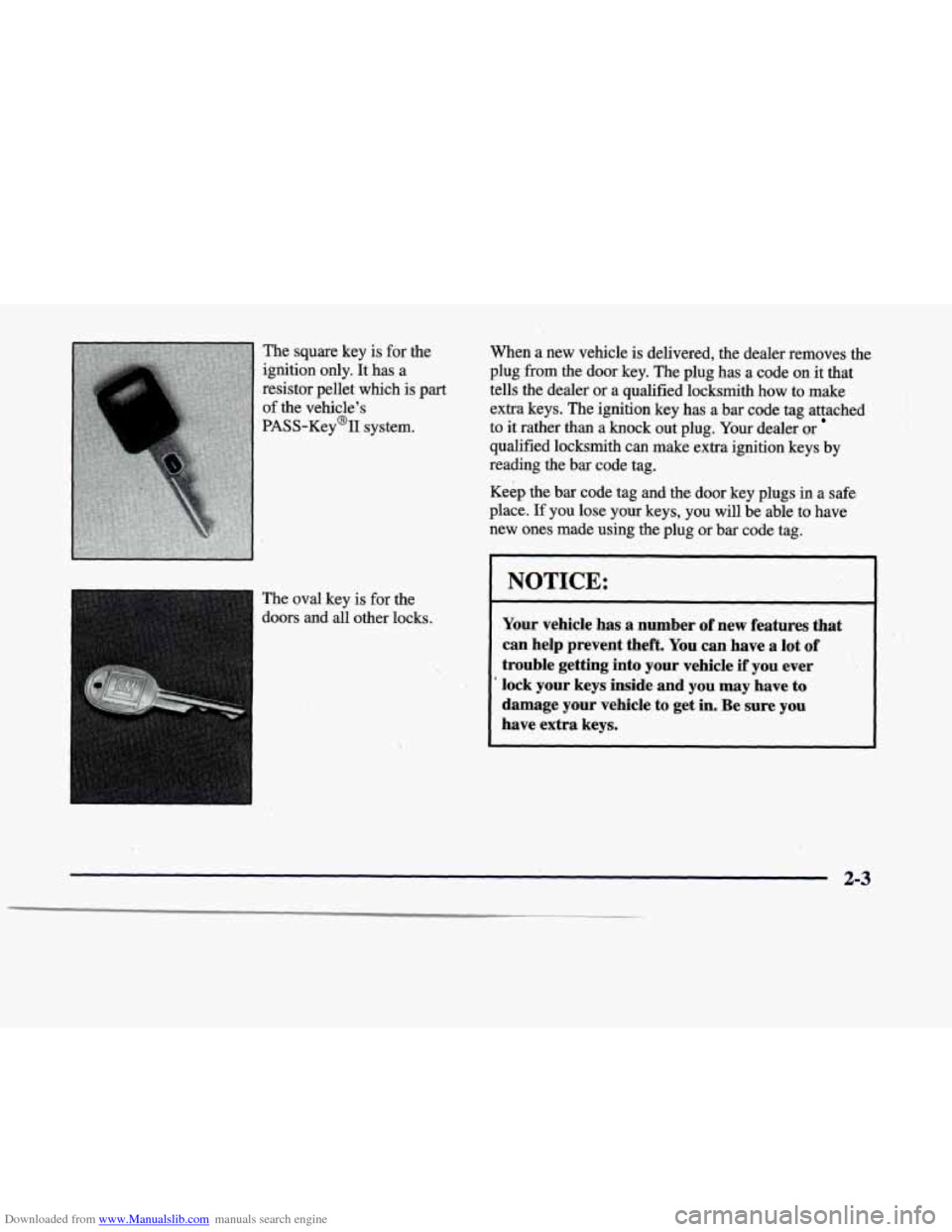
Downloaded from www.Manualslib.com manuals search engine The square key is for the
ignition only. It has a
resistor pellet which is part
of the vehicle’s
PASS-Key% system.
The
oval key
doors and all is
for the
other locks. When
a new vehicle is delivered, the dealer removes the
plug
from the door key. The plug has a code on it that
tells the dealer or a qualified locksmith how to make
extra keys. The ignition key has a
bar code tag attached
to it rather than a knock out plug.
Your dealer or
qualified locksmith can make extra ignition keys by
reading the
bar code tag.
Keep the
bar code tag and the door key plugs in a safe
place. If you lose your keys, you will be able to have
new ones made using the plug or
bar code tag.
NOTICE:
Your vehicle has a number of new features that
can help prevent theft. You
can have a lot of
trouble getting into your vehicle if you ever
lock your keys inside and you
may have to
damage your vehicle
to get in. Be sure you
have extra keys.
2-3
\.
Page 75 of 386
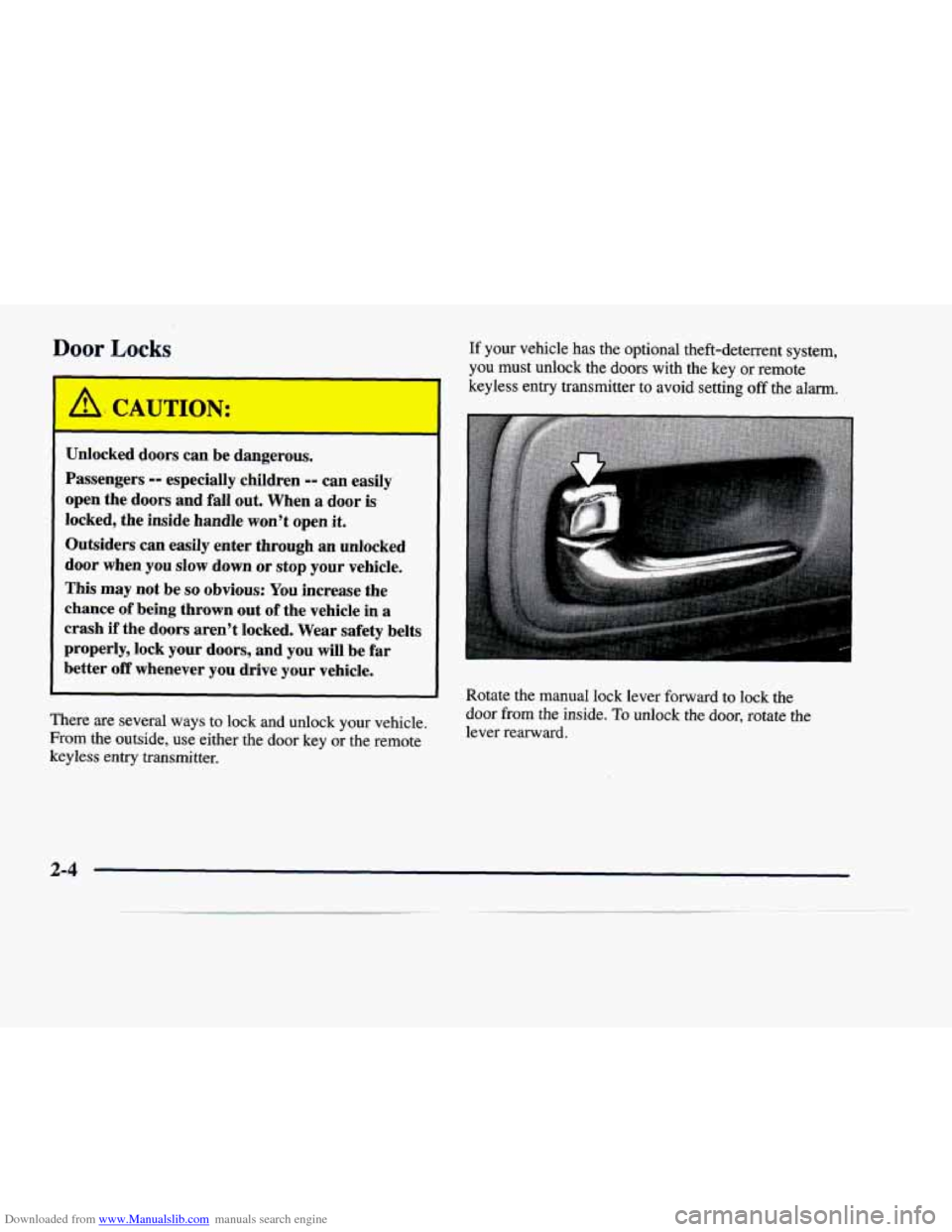
Downloaded from www.Manualslib.com manuals search engine Door Locks
1 A. CAUTION:
If your vehicle has the optional theft-deterrent system,
you must unlock the doors with the key or remote
keyless entry transmitter to avoid setting
off the alarm.
Unlocked doors can be dangerous.
Passengers
-- especially children -- can easily
open the doors and fall out. When
a door is
locked, the inside handle won’t open it.
Outsiders can easily enter through an unlocked
door when you slow down or stop your vehicle.
This may not be
so obvious: You increase the
chance
of being thrown out of the vehicle in a
crash
if the doors aren’t locked. Wear safety bel
properly, lock your
doors, and you will be far
better
off whenever you drive your vehicle.
.ts
There are several ways to lock and unlock your vehicle.
From the outside, use either the door key or the remote
keyless entry transmitter. Rotate
the manual lock lever forward to lock
the
door from the inside. To unlock the door, rotate the
lever rearward.
2-4
Page 76 of 386
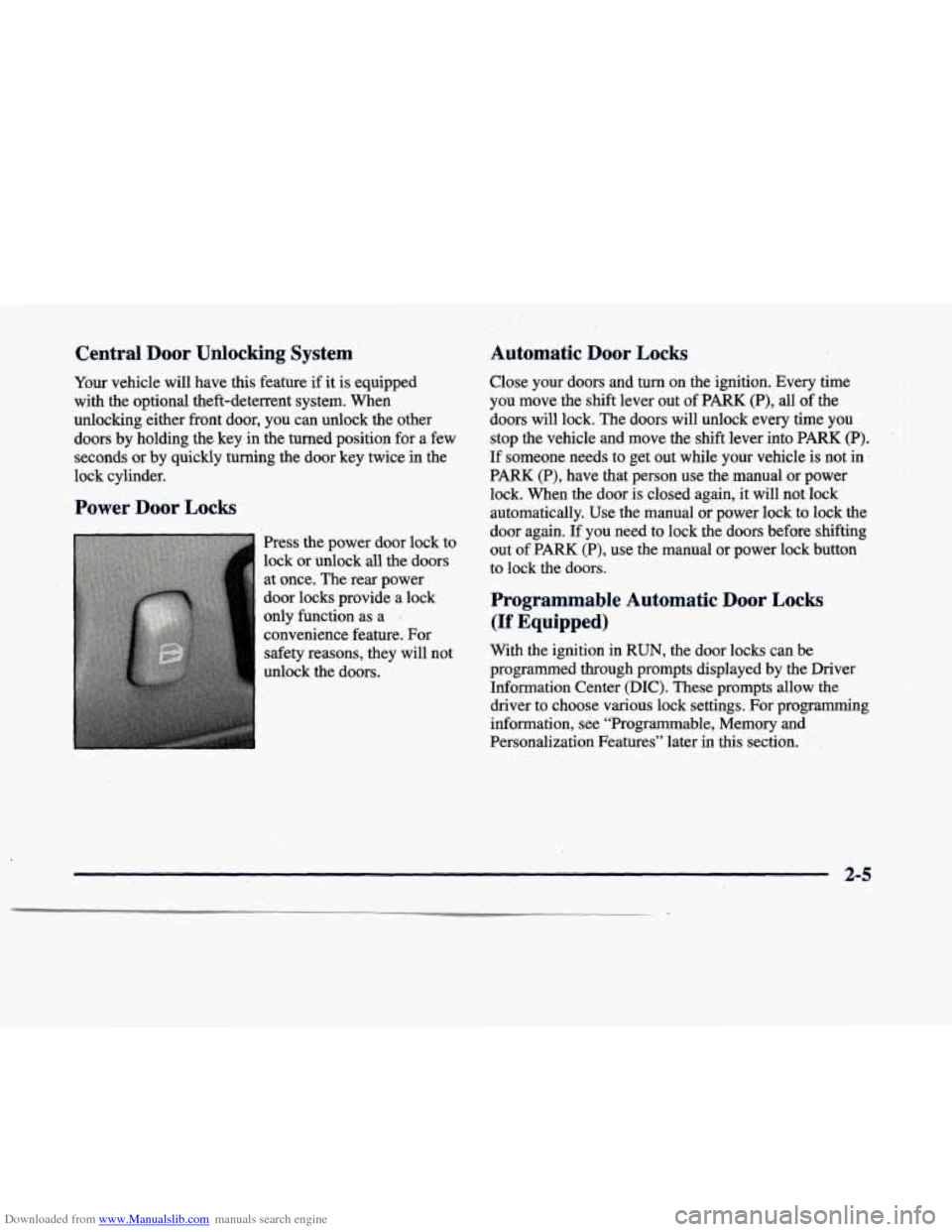
Downloaded from www.Manualslib.com manuals search engine Central Door Unlocking System
Your vehicle will have this feature if it is equipped
with the optional theft-deterrent system. When
unlocking either front door, you can unlock the other
doors by holding the key in the turned position for a few
seconds or by quickly turning the door key twice in the
lock cylinder.
Power Door Locks
Press the power door lock to
lock
or unlock all the doors
‘at’once. The rear power
door locks provide a lock
only function as a I
convenience feature., For
safety reasons, they will not
unlock the doors.
Automatic Door Locks
Close your doors and turn on the ignition. Every time
you move the’ shift lever out
of PARK (P), all of the
doors will lock. The doors will unlock every time you
stop the vehicle and move the shift lever
into PARK (P). ’
If someone needs to get out while your vehicle is not in -
PARK (P), have that person use the manual or power
lock. When the
door is closed again, it will not lock
automatically. Use the manual or power lock to lock the
door again.
If you need to lock the doors before shifting
out
of PARK (P), use the manual or power lock button
to lock the doors.
Programmable Automatic Door Locks
(If Equipped)
With the ignition in RUN, the door locks can be I
programmed through prompts displayed by the Driver I
Information Center (DIC). These prompts allow the
driver to choose
various lock settings. For programming
information, see “Programmable, Memory and
Personalization Features” later
in this section.
2-5
Page 77 of 386
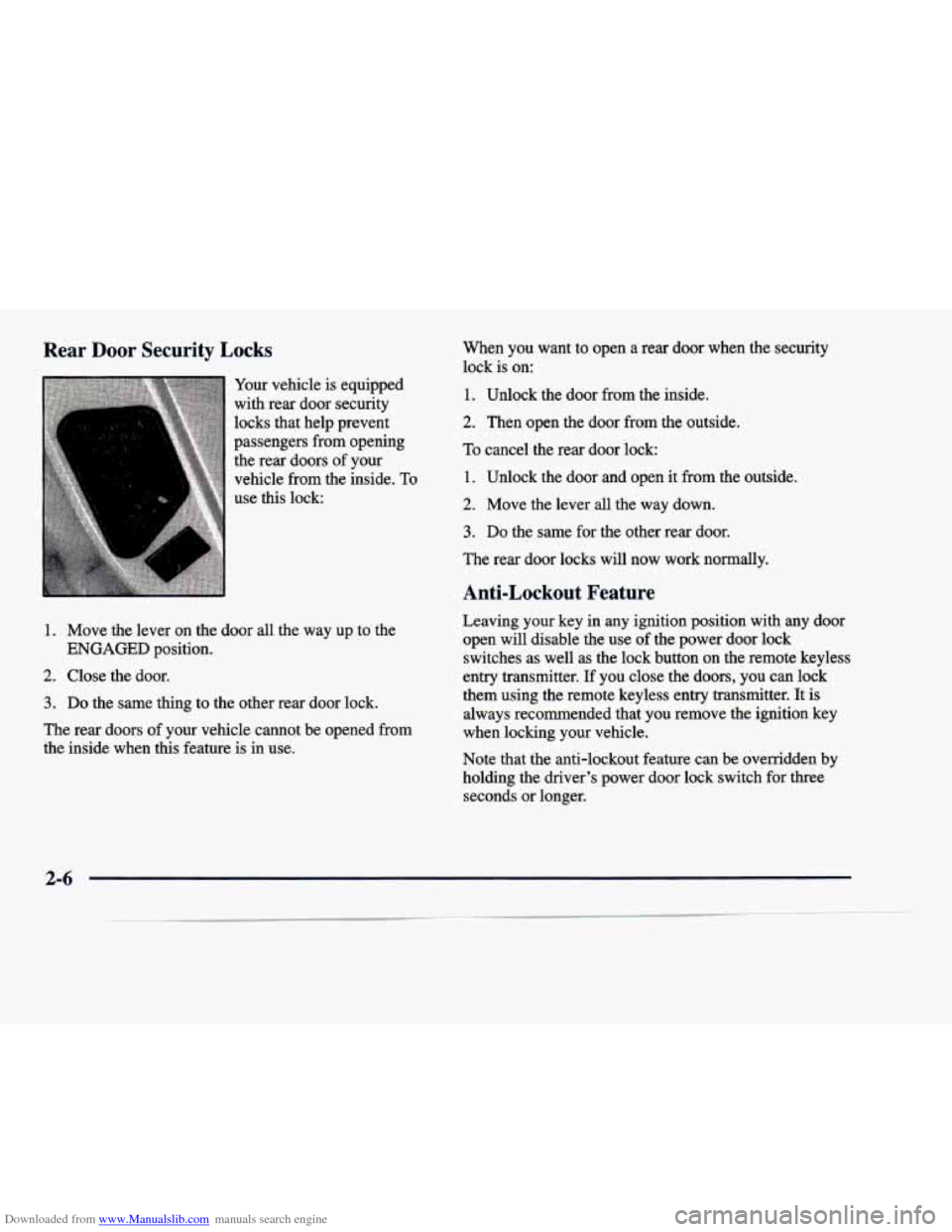
Downloaded from www.Manualslib.com manuals search engine Rear Door Security Locks
Your vehicle is equipped
with rear door security
locks that help prevent
passengers from opening
the rear doors of your
vehicle from the inside.
To
use this lock:
1. Move the lever on the door all the way up to the
2. Close the door.
ENGAGED position.
3. Do the same thing to the other rear door lock.
The rear doors
of your vehicle cannot be opened from
the inside when this feature is in use. When
you want to open a rear door when the security
lock is on:
1. Unlock the door from the inside.
2. Then open the door from the outside.
To cancel the rear door lock:
1. Unlock the door and open it from the outside.
2. Move the lever all the way down.
3. Do the same for the other rear door.
The rear door locks will now work normally.
Anti-Lockout Feature
Leaving your key in any ignition position with any door open will disable
the use of the power door lock
switches
as well as the lock button on the remote keyless
entry transmitter. If you close the doors, you can lock
them using the remote keyless entry transmitter. It
is
always recommended that you remove the ignition key
when locking your vehicle.
Note that the anti-lockout feature can be overridden
by
holding the driver's power door lock switch for three
seconds or longer.
2-6